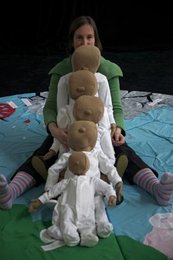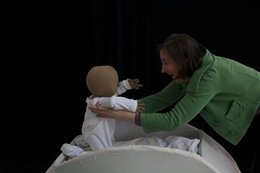She stands there on the bare stage as we enter, resplendent in a dress shaped like a sliced pizza. You can’t help but laugh, and the ice has been broken. Curious as to whom this strange person is, the children, aged 3-6, turn to their parental units, point, question and quarrel amongst themselves as to what is going on. Having uttered nary a word Niamh Lawlor has got the children in attendance engaged with her one-woman show Tic Teac, Tic Teac. The challenge now is to keep them on side.
 Púca Puppets developed this bi-lingual puppet piece for young children with a group of pre-schoolers. Hence it knows the importance of making them laugh, making them feel safe and perhaps most importantly accepts their high spirits as part of the performance. As such, Lawlor nails the important pre-show engagement crucial to settling tots into what is likely to be an unfamiliar theatrical world. Their quiet observation is out of the question, so she ensures they know that this show is ‘about them’, bringing them into the performance space and getting them to pull her dress asunder, revealing the pieces of a puzzle which needs to be fitted together. Working in unison a clock is assembled, each part marked with numbers and seasons, and, holding hands, the show's simple theme song is sung together – in Irish, then English – as they walk in a circle around the passing of time: “Tic-a-teac-a-tic-a-teac-a-tic-a-teac-a-tic, you were small and now you're big!”
Púca Puppets developed this bi-lingual puppet piece for young children with a group of pre-schoolers. Hence it knows the importance of making them laugh, making them feel safe and perhaps most importantly accepts their high spirits as part of the performance. As such, Lawlor nails the important pre-show engagement crucial to settling tots into what is likely to be an unfamiliar theatrical world. Their quiet observation is out of the question, so she ensures they know that this show is ‘about them’, bringing them into the performance space and getting them to pull her dress asunder, revealing the pieces of a puzzle which needs to be fitted together. Working in unison a clock is assembled, each part marked with numbers and seasons, and, holding hands, the show's simple theme song is sung together – in Irish, then English – as they walk in a circle around the passing of time: “Tic-a-teac-a-tic-a-teac-a-tic-a-teac-a-tic, you were small and now you're big!”
This is their own story, the story every child adores, of how they came to be and as the children return to their seats they do so charged with a freedom to play, their excitement focused on interacting with what Lawlor does.
With a 'boing' the show itself starts, with Lawlor switching easily between Irish and English in a way that is neither complicated nor repetitive, as she guides us through the many stages of growth and development the children themselves have only recently experienced.
There’s no need for birds, bees or storks as using a laser and a bodhrán Lawlor creates the egg, sperm and foetus in a way that is neither confusing nor disgusting – simple and effective design side-stepping one of life’s more awkward parental moments without lying to the children.
The aesthetic is key to keeping what has just passed fresh in the mind, as disposing of the aforementioned props, she calls on a number of faceless, yet remarkably lifelike puppets, to show the different stages of development. There is the crying baby who spits up on her, the curious crawler who overreacts to the slightest upset, the shy tot who’s just learned to walk and prefers peek-a-boo to straight interaction, and of course the puppet closest in age to them, too big for bed, full of boldness and brass.
 As the story develops the change of growth is marked by the puppets' clothes, which are taken off after each segment and hung across a washing line, from a baby’s onesie to a pre-schooler's shirt and jumper, a visual clue as to how much a child grows in those first years.
As the story develops the change of growth is marked by the puppets' clothes, which are taken off after each segment and hung across a washing line, from a baby’s onesie to a pre-schooler's shirt and jumper, a visual clue as to how much a child grows in those first years.
Throughout Lawlor defers to the kids, getting them to draw on their own life experience to surmise what’s going on, while exhibiting an astonishing ventriloquism that had me searching for the mic when she voices the puppets. She uses funny but pointed humour that cracked the kids up but also had them see the point to the whole charade, her huge faces and gesticulation keeping focus at all times.
With imagination and charm, Púca Puppets involved the children in an artistic process that showed them their own experience on stage and kept them engaged and entertained for near on 45 minutes. Short but sweet; the children will continue the story themselves.
Caomhan Keane writes about theatre for The Sunday Independent and entertainment.ie